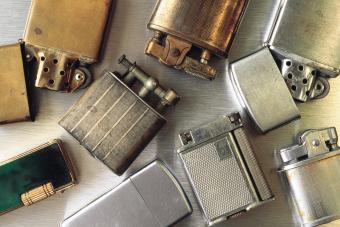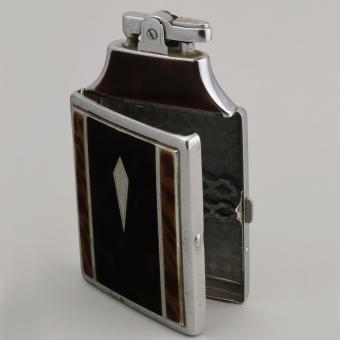
Recreational tobacco use dominated the 19th and 20th centuries, and inventors of the period continued to create new ways to light people's tobacco. In a short period of time, hundreds of patents were submitted in Europe and the United States, each one boasting a competitive, unique design. While these early artifacts from the lighter industry's infancy are hard to find today, it makes actually finding one and owning it all the more satisfying.
The History of Antique Lighters
In 1823, a German chemist perfected the world's first lighter, and it was referred to as the Feuerzeug or the Döbereiner's Lamp, in honor of its inventor, Johann Wolfgang Döbereiner. This lighter, and other lighters from the 19th century, were relatively unstable given the amount of heat that they put off. They were also dangerous because of the fuel that was needed to be used to catalyze a flammable reaction. These early lighters were cumbersome and impractical, but also marked an incredible technological advancement.
Once these tabletop lighters entered the market, other manufacturers began to experiment with making pocket-sized lighters, portable lighters, and striking mechanisms that were safer than those previously released. A number of different lighters grew to popularity in the 1880s and 1890s, but it wasn't until 1903 that the conventional lighters we know today were born.
In 1903, Baron Carl von Welsbach patented ferrocerium, the material that's known today as flint. These semi-automatic--and later, automatic--flint lighters gave people more stability in their flames and allowed lighters to become smaller and smaller. Yet, the handheld lighters of the 1920s and 1930s are seen as some of the most collectible examples on the market.
Manufacturers of Antique Lighters
Although there were many lighter manufacturers operating in the 19th and early 20th centuries, two names that still stand out to most people are Ronson and Zippo.
Ronson
The Ronson Company had its beginning in 1886 when it was founded by Louis V. Aronson under the name Ronson Art Metal Works. In 1913, the company marketed its first lighter, the Wonderliter, and it was a huge success. Another popular design was Ronson's Banjo lighter, which was released in 1926; The Banjo lighter, with its unique shape, was an automatic lighter that could be lit and extinguished with the simple push and release of a button. In addition, collectors also enjoy the Comet and Varaflame lighter models as well.

Zippo
Unfortunately, Zippo lighters are not currently considered antiques as it hasn't been 100 years since the time that the first Zippo was produced. However, their name is synonymous with historic lighters, and they're by-far the most popular lighter for casual collectors to have. Founded by George Blaisdell in 1932, the Zippo Manufacturing Company created its own version of a wind-resistant lighter, and partnered with the United States Armed Forces to provide Zippos to their soldiers. This widespread access and familiarity with the brand during World War II directly contributed to its massive popularity in the 1940s and 1950s.

Additional Manufacturers
While Ronson and Zippo are the best known of these lighter companies, a few others have stood the test of time. Here are some additional lighter manufacturers:
- Scripto
- Colibri Group
- Evans Case Company
- American Safety Razor Company
- Stratoflame
- Rowenta
Identifying Antique Lighters
Given the fact that 19th century lighters all have varying shapes, it can make identifying them difficult for novice collectors. In general, these lighters share a few characteristics: they're made out of metallurgical materials, are circular or rectangular in shape, and are about the size of the palm of a hand. To help you get started, Vintage Lighter Book has an incredible online collection of pre-flint and post-flint lighters that you can browse through. Here are the main types of antique lighters that you might come across in your search.
- Tabletop Lighter: This very early type of lighter was designed to be rested on a tabletop and had both a fuel receptacle and a fusee.
- Automatic Match Lighter: There are multiple shapes that this lighter took the form of, but the basic function is that the press of a button would light, release, and hold a match for you to use.
- Pellet Match Lighter: Taking the same concept as the Automatic Match Lighter but advancing it further, this lighter ignited and held tiny pellets that resembled match heads.
- Friction Lighter: Incorporating the oldest way to light a fire, Friction Lighters involved the user pressing a button which would spin a steel piece against a stone surface that would set off sparks and ignite a fusee.
- Rack Lighter: This type of lighter uses speed and friction to ignite its flame; just make sure to press down hard on the extended button.
- Cap Lighter: These lighters resemble modern lighters more closely and feature metal caps on the inside of the cartridges to aid in the lighting process.
Antique Lighter Values
Unfortunately, there're not a lot of antique lighters currently available on the market; if you're really interested in owning one, you're going to have to put in a little bit of work to find one. However, the majority of these early lighters are actually listed for cheaper than newer ones are, due in large part to the fact that Art Deco lighters and Mid-Century lighters are by-far more popular among collectors. Therefore, you can easily find an antique lighter for anywhere between $25-$100. For example, in one online auction, this antique table lighter sold for $50. Similarly, condition, brand name, and rarity can all have an impact on the final price.
Light Up Your Life
While antique lighters give you a glimpse into the recreational activities of people in the past, they can also just look incredibly cool sitting in a display case or shadow box. So long as these antique lighters have been cleaned of their flammable materials (fuels or matches) they should be completely safe, and they make for a great Father's Day gift for the tobacco aficionados in your life.







